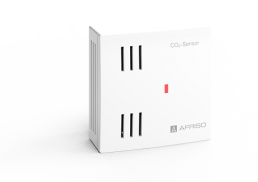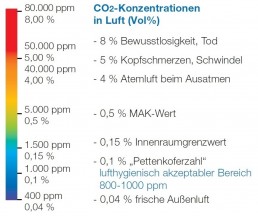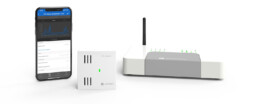
CO2 room air monitoring reduces the risk of infection
The coronavirus spreads, among other things, via droplet infections and aerosols. The potential risk of infection indoors can be significantly reduced by timely, regular and adequate ventilation.
Aerosols are ultra-fine airborne liquid particles and droplet (<5 µm). They are released when you breathe and speak – sneezing and coughing create even more droplets. Depending on their size, the particles stay in the air for a certain period of time and sink to the ground at different rates. While virus transmissions by aerosols in outdoor areas are relatively rare, the likelihood of exposure to droplets and aerosols is significantly increased indoors within a radius of 1 to 2 m from an infected person. Staying in poorly ventilated rooms can increase the likelihood of transmission even over long distances, especially if an infectious person emits many particles. Due to the distribution of aerosols in the room air, maintaining the minimum distance or setting up partition walls is often no longer sufficient: A major problem especially for schools, kindergartens, care facilities or companies with open-plan offices and meeting rooms. Learning, playing and working together in closed rooms over a longer period of time becomes a risk!
Timely ventilation reduces the risk of infection

LED green = Air quality in the room is good, no ventilation required (CO2 concentration < 1,000 ppm)

LED yellow = ventilation recommended, check ventilation behaviour (CO2 concentration between 1,000 and 1,500 ppm)

LED rot = Ventilation required (CO2 concentration > 1,500 ppm)
Exemplary particle spread in a classroom with ventilation with tilted windows. Assumption: One student coughs periodically.
Source: Technical University Berlin, Hermann-Rietschel Institute.
Staying in poorly ventilated rooms
The carbon dioxide (CO2) and the aerosols created by humans pollute the room air, as do concentrations of other air pollutants from building materials, furnishings or household chemicals. Without appropriate ventilation, indoor air hygiene and the ability to concentrate decrease and contagious aerosol concentrations increases enormously. A current study by the Hermann Rietschel Institute (TU Berlin) provides evidence that the CO2 is an ideal indicator for aerosol concentration, as humans permanently release CO2 and aerosols into the air*. Because of this direct relationship, persons can stay in a room for a certain period of time until a certain amount of virus is inhaled. Increased and well-planned exchange of air with unpolluted fresh air can keep the CO2 and aerosol concentration low in the long term. The lower the CO2 concentration, the lower the amount of aerosols that persons in the room can inhale. The risk of infection is reduced!
CO2 as the most important benchmark for indoor air hygiene
Optimum indoor air hygiene also increases cognitive performance. 1,000 ppm (parts per million) as a reference value for the CO2 concentration in living rooms and other rooms were recommended by the hygienist Max von Pettenkofer as early as 1858. The “Pettenkofer number” has become an important threshold value in the technical regulations for workplaces (ASR A3.6). For example, at concentrations higher than 1,000 ppm, countermeasures for air exchange must be initiated and documented by the occupational safety officer in the risk assessment.
The cognitive performance of persons who study or work in environments with a maximum of 600 ppm CO2 is approximately twice as high as that of persons staying in rooms with a CO2 concentration of 1,000 ppm. The fresh air requirement indoors amounts to approximately 54 m³/h per person for the “hygienically acceptable range” (<800 ppm CO2).**

CO2 concentrations, limit values and health effects on humans.
Measuring CO2 and providing for ventilation in a targeted way

CO2 concentrations for targeted ventilation measures can be determined with little effort using CO2 sensors. The AFRISO CO2 sensor displays the concentration using an easily understandable “traffic light” directly on the housing. With this discreet LED display, users always have the ventilation recommendations in view without work or learning being impaired by acoustic signals. If the value increases and the LED turns yellow, the threshold of 1,000 ppm CO2 has been exceeded. When the LED turns red, the concentration exceeds 1,500 ppm, and it is high time to ventilate. Once the LED lights green again, the value is below 1,000 ppm and the windows can be closed. This ensures that windows are not kept open for an unnecessarily period of time and saves heating costs.

If you want to see the exact CO2 concentration displayed at any time or want to use the measured values as a trigger for further action, the AFRISO CO2 sensor F is the device of choice. The EnOcean wireless version can be integrated into the AFRISO smart home system in order to switch the domestic ventilation system and other alarm devices or to adjust the heating system during ventilation. The relationships between the sensors and actuators can be established intuitively in the AFRISOhome app using “IF-THEN” links. You can set alarm thresholds and have push notifications sent to smartphones or e-mails if desired. This way, the optimum balance between ideal indoor air hygiene and low energy consumption can be achieved even during the heating season.

If more than one person is staying, it is hardly possible to fully rule out a COVID-19 infection. However, ventilation can be controlled depending on the measured CO2 concentration so that sufficient fresh air is supplied. From an epidemiological perspective to reduce the risk of infection, during the corona pandemic, the CO2 reference value for the best ambient air quality in rooms with intensive use should not be exceeded; from a health point of view, CO2 values below 600 ppm are ideal. Carbon dioxide monitoring supports efficient, targeted and energy-saving ventilation measures, serves health and also promotes performance and vitality.

The consequences of excessive CO2 concentration in everyday school life are reduced performance, fatigue, a high error rate and a generally reduced level of wellbeing. AFRISO CO2 sensors provide reliable information with a colour LED on the current indoor air quality and the correlating aerosol pollution. The mobile use of the CO2 sensor is particularly practical for teachers, lecturers and everyone who has to work in different rooms, because thanks to the plug connection, there are no power cables and the sensor can be plugged directly into any Schuko CEE mains socket.
* Vgl. “Anzahl der mit SARS-CoV-2 beladenen Partikel in der Raumluft und deren eingeatmete Menge, sowie die Bewertung des Infektionsrisikos, sich darüber mit Covid-19 anzustecken” (“Number of particles loaded with SARS-CoV-2 in the room air and its inhaled quantity, and the evaluation of the risk of infection with Covid-19 through them”); Hermann-Rietschel-Institut an der Technischen Universität Berlin, 2020-11-17: http://dx.doi.org/10.14279/depositonce-10655.3
** See specification ventilation rate per person with average indoor air quality according to classification as per EN 13779.

